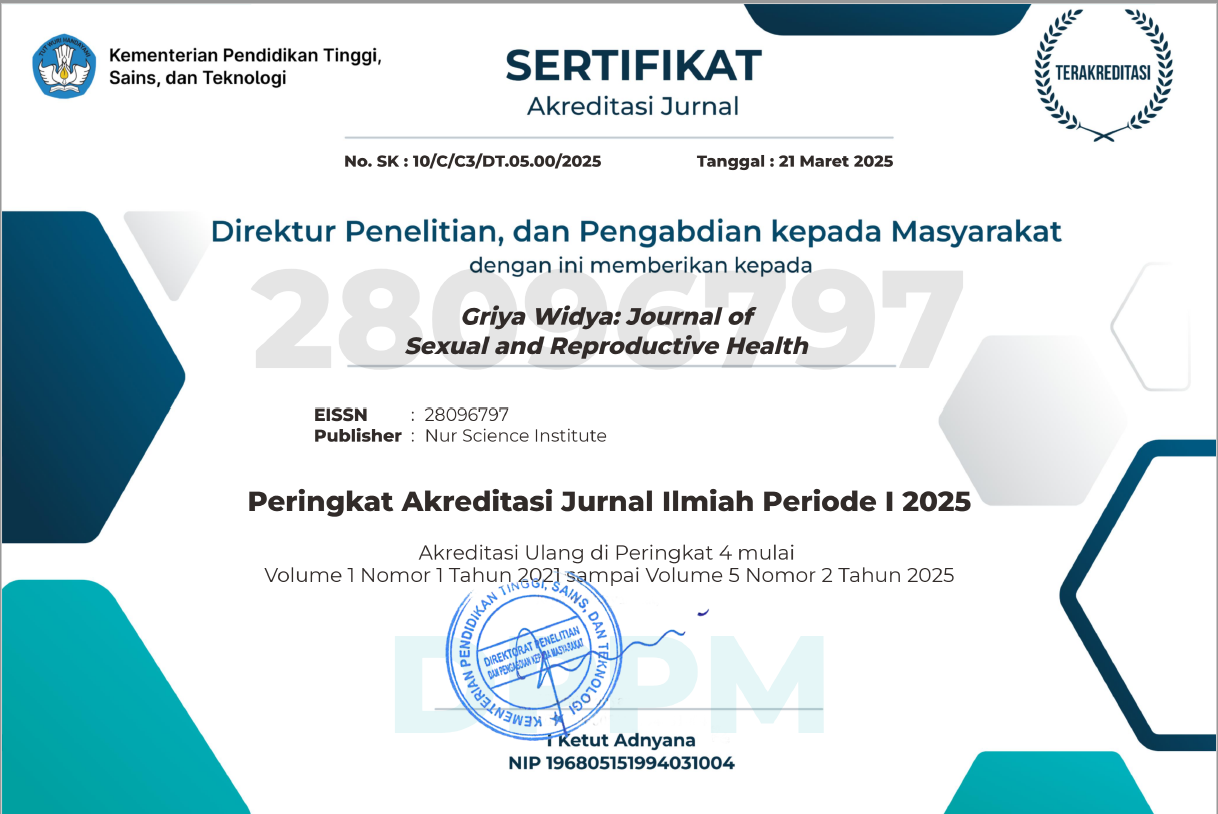Hubungan Umur Kawin Pertama, Penggunaan Kontrasepsi dan Fertilitas Remaja dengan Pendidikan Remaja Wanita
DOI:
https://doi.org/10.53088/griyawidya.v2i1.568Keywords:
Age of First Mating , Contraceptive Use , Adolescent Fertility , Female EducationAbstract
Background: The purpose of the study was to determine the relationship between adolescents' first mating age, contraceptive use and adolescent fertility with women's education
Method: This was an analytical observational study with a cross-sectional study design, independent variables are the age of first marriage, the use of contraception and adolescent fertility and the dependent variable is female education. The population and samples in this study are data from the Performance Survey and Accountability Program (SKAP) KKBPK BKKBN North Sulawesi Province in 2018. The data from the study were analyzed univariately and bivariately using the Correlation test.
Results: Statistical test proved that there is a meaningful relationship between the first marriage age of adolescents and the education of adolescent women, with a p value = 0.008, correlation value = 0.736 which has a strong correlation level between first marriage age and female education, there is a meaningful relationship between contraceptive use and female adolescent education, who obtained a p value = 0.019 correlation value = 0.843 which has a strong correlation level between The use of contraception with the education of adolescent women and there is a meaningful relationship between adolescent fertility and adolescent education of women who obtain a p value = 0.001 correlation value = 0.911, namely adolescent fertility has a very strong correlation with the level of education of adolescent women.
Suggestion: The government needs to pay attention to the implementation of policies on adolescents, especially reproductive health issues, and create effective programs for the distribution of reproductive health information for adolescents.
References
Badan Kesejahteraan dan Keluarga Berencana Nasional. (2014). Laporan Akhir Kajian Faktor Sosial Ekonomi yang Berdampak pada Usia Perkawinan Pertama di Provinsi Gorontalo. Gorontalo: BKKBN provinsi Gorontalo.
Darnita. (2013). Faktor-faktor Penyebab Pernikahan Usia Muda. Aceh: Kebidanan STIKes U’Budiyah Banda Aceh. Equality Vol. 11.
Depkes RI. (2006). Lebih 1,2 Juta Remaja Indonesia Sudah Lakukan Seks Pranikah.
Fadlyana, E., & Larasati, S. (2009). Pernikahan usia dini dan permasalahannya. Sari Pediatri, 11(2), 136-140.
Fuad C., Radiono S., Paramastri I. (2003) Pengaruh Pendidikan Kesehatan Seksual Terhadap Pengetahuan dan Sikap Remaja dalam Upaya Pencegahan Penularan HIV/AIDS di Kodia Yogyakarta. Berita Kedokteran Masyarakat XIX/IXI – 60; UGM Yogyakarta.
Kementerian Kesehatan RI. (2018). Data dan informasi profil kesehatan Indonesia 2017. Kementerian Kesehatan.
Kinnaird. (2003). Keluarga Makin Baik Hubungan Orangtua-Remaja Makin Rendah Perilaku Seksual Pranikah.
Kurniawati L, Nurpchmah S dan Katmawanti S. (2017). Hubungan Antara Tingkat Pendidikan, Status Pekerjaan Dan Tingkat Pendapatan Dengan Usia Perkawinan Pertama Wanita Di Kelurahan Kotalama Kecamatan Kedungkandang Kota Malang.
Monks F.J., Knoers A.M.P., Haditono S.R. (2002). Psikologi Perkembangan Pengantar dalam Berbagai Bagiannya, Edisi Keempat Belas. Yogyakarta: Gadjah Mada University Press.
Qibtiyah M. (2014). Faktor yang Mempengaruhi Perkawinan Muda Perempuan. Jurnal Biometrika dan Kependudukan, Vol. 3 No. 1 Juli 2014.
Raharja, M. B. (2014). Fertilitas remaja di Indonesia. Kesmas National Public Health Journal, 9(1).
Rismawati S. (2015). Unmet need : Tantangan program keluarga berencana dalam menghadapi ledakan penduduk tahun 20309 May 2015.
Risya, D. (2011). Usia Perkawinan Pertama Wanita Berdasarkan Struktur Wilayah Kabupaten Bogor. Skripsi. Depok: FKM UI.
Rizkianti A, Amaliah N dan Racmalina R. (2017). Penggunaan Kontrasepsi pada Remaja Perempuan Kawin di Indonesia (Analisis Riskesdas 2013). Buletin Penelitian Kesehatan, Vol. 45, No. 4 Desember 2017
Soetjiningsih. (2006). Remaja Usia 15 - 18 Tahun Banyak Lakukan Perilaku Seksual Pranikah.http://www.ugm.ac.id/index.php?page=rilis&artikel=1659
Suryoputro A., Nicholas J.F., Zahroh S. (2006). Faktor-faktor yang mempengaruhi Perilaku Seksual Remaja Di Jawa Tengah: Implikasinya Terhadap Kebijakan Dan Layanan Kesehatan Seksual Dan Reproduksi. Makara Kesehatan. vol.10. no.1 juni 2006.
Taufik. (2005). Perilaku seks di surakarta. http://elfarid.multiply.com/journal/item/306
UNFPA. (2015). Girlhood, not motherhood: Preventing adolescent pregnancy. https://www.unfpa.org/sites/default/files/pub pdf/Girlhood_not_motherhood_final_web.pdf
UNFPA. (2016). Facing the facts : Adolescent girls and contraception. https://www.unfpa.org/sites/default/files/ resourc e-pdf/UNFPA_Adolescent_brochure
Utomo ID, Utomo A. Adolescent Pregnancy in Indonesia: A Literature Review: UNFPA; (2013). Available from: http://indonesia. unfpa.org/application/assets /publications/ Executive_Summary_WPD_2013
WHO. (2018). Adolescents: health risks and solutions. http://www.who.int/en/news-room/fact-sheets/detail/adolescents-health-risks-and solutions
Downloads
Published
How to Cite
Issue
Section
License
Copyright (c) 2022 Dismo Katiandagho, Budi Setiawan, Daniel Hamonangan, Agustien Mamahit

This work is licensed under a Creative Commons Attribution-ShareAlike 4.0 International License.
Authors who publish with this journal agree to the following terms:
The author(s) retain copyright and grant the journal the right of first publication with the work simultaneously licensed under a CC BY-SA 4.0 license that allows others to remix, adapt, and build upon the work even for commercial purposes, as long as they credit the author(s) and license their new creations under the identical terms.
License details: https://creativecommons.org/licenses/by-sa/4.0/



